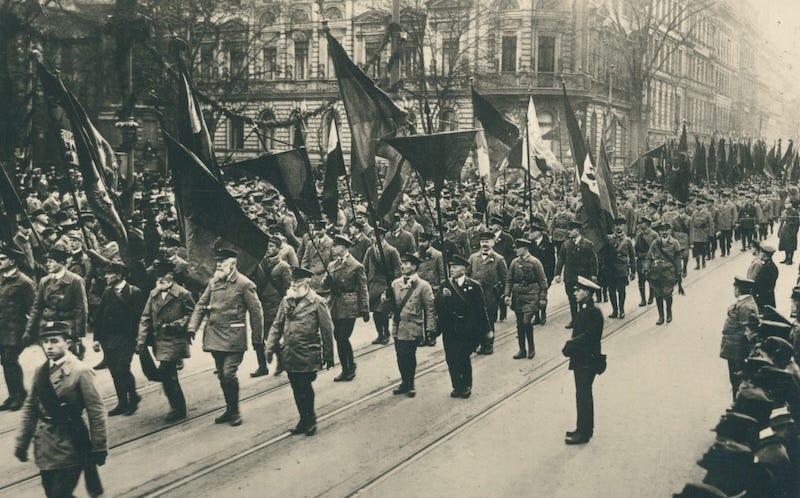The Weimar Republic was every bit as militarized as the United States and it revered its military and its veterans in much the same excessive manner. Particularly in Prussia, there were numerous militias, the Freikorps, some dating back centuries, which served as veterans associations, recruitment pools, and as reserves for the imperial army.
One of these was the Reichsbanner, literally the flag of the republic. While the Reichsbanner was officially a multiparty militia, it was closely tied to the German Sozialdemokratische Partei Deutschlands, the SPD.
In 1919 a different Freikorps militia, the Garde-Kavallerie-Schützen-Division, reporting to the newly-elected SPD government and its Defense Minister, together with elements of the German army, planned and carried out the assassinations of German communists Karl Liebknecht and Rosa Luxemburg. The killers, who ranged from the German Defense Minister himself to enlisted men, were all acquitted by a military court and the disposition of the case was approved by the SPD. The two victims, after all, were despised communists.
By 1933, hostile to both Kommunisten and Nationalsozialisten alike, the remaining SPD-oriented militias calculated that navigating a timid middle course would save not only the republic but themselves from metastasizing fascism. The story of how this strategy failed spectacularly, and the Reichsbanner was systematically erased by Nazis, is told in William Sheridan Allen's book, The Nazi Seizure of Power (1973).
So when the Trump administration begins demanding personal loyalty oaths from individual military units and purging elements displaying any independence or concern for the Constitution, think back on the following passage from Allen's book (p. 180):
The Reichsbanner, with all its plans for instant mobilization, had its members struck down one by one, its leaders imprisoned, beaten, hounded from their jobs and their homes without any resistance from the organization as a whole.
Perhaps the basic reason for this was that there was no Nazi coup d'état. Instead, there was a series of quasi-legal actions over a period of at least six months, no one of which by itself constituted a revolution, but the sum of which transformed Germany from a republic to a dictatorship.
The problem was where to draw the line. But by the time the line could be clearly drawn, the revolution was a fait accompli, the potential organs of resistance had been individually smashed, and organized resistance was no longer possible. In short, the splendid organization was to no avail; in the actual course of events it was every man for himself.
The Thalburger Reichsbanner itself was ready to fight in 1933. All it needed was the order from Berlin. Had it been given, Thalburg's Reichsbanner members would have carried out the tested plan they had worked on so long — to obtain and distribute weapons and to crush the Nazis. But Thalburg's Reichsbanner would not act on its own. The leaders felt that single acts would come to grief, would possibly compromise the chance when it finally did come, and would, in any event, be a betrayal of discipline. They felt that their only hope was in common action, all together, all over the Reich. Hadn't the former SPD governor of Hannover, Gustav Noske, said that only a counterattack should be made? So they waited and prayed for the order to come, but it never did.
And while they waited the Nazis began tracking them down, one by one. Finally it was clear that there would never be an order...





I hadn't seen this when I posted the last essay.
Apparently Trump *is* checking the allegiance of military units. The military officers who are complicit with this slow-moving Putsch must be prosecuted along with Trump.
https://www.military.com/daily-news/2025/06/11/bragg-soldiers-who-cheered-trumps-political-attacks-while-uniform-were-checked-allegiance-appearance.html